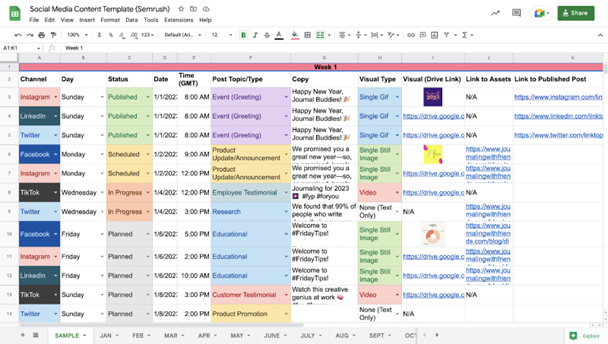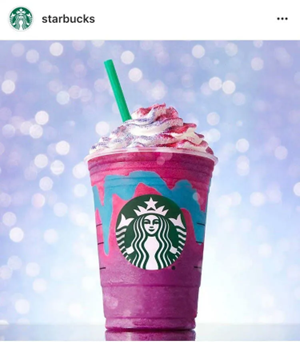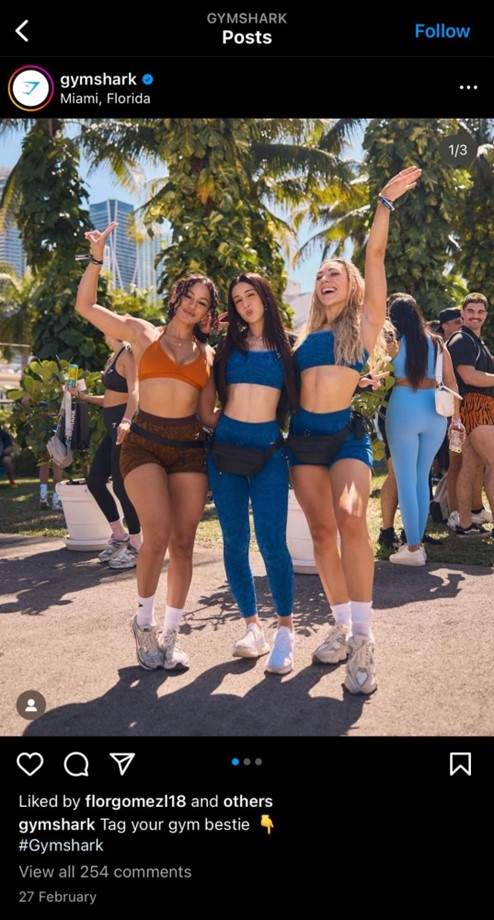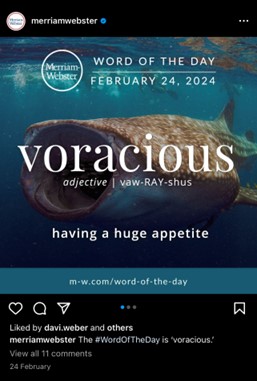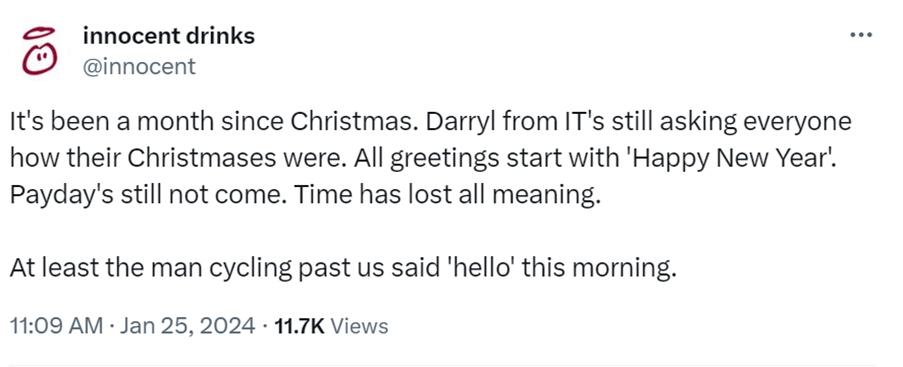Whether you're a multinational corporation worth billions, or a local startup hustling from the garage, the message remains crystal clear: in today's landscape, social media is not just an option; it's an imperative.
But whether you're a B2B or B2C company, standing out in the sea of online content requires more than just a presence – it demands authenticity.
According to Social Media Today, a staggering 86% of consumers cite authenticity as a key factor when deciding what brands they like and support. This isn’t just a buzzword, it’s what turns scrollers into loyal followers and converts them into customers.
Unfortunately, achieving real authenticity on social media isn’t as easy as it sounds. To create something tangible and engaging, you need a plan.
Which is where we come in!
Here’s our ultimate guide for creating powerful, authentic digital content on social media for your brands.
What is social media content creation?
Social media content creation is the process of producing any type of content, such as text, video, photography, or infographics for social media platforms like Instagram, TikTok, Facebook, or LinkedIn. This type of content can promote brands, engage audiences, and increase creators’ visibility on their platforms.
Why is social media content important for your business?
There are over 4.95 billion social media users around the world.
Collectively, we spend close to 12 billion hours on social media each day, so it’s no wonder that brands are all over this space as well. In fact, social media has become an increasingly indispensable tool for enterprises aiming to reach and engage with the public.
Reach and accessibility
These platforms offer unparalleled reach and accessibility for increased brand awareness. Social media platforms like Facebook, Instagram, X, TikTok, and LinkedIn provide creators with an unprecedented opportunity to connect with their target prospects, clients, or other creators on a massive scale.
Whether you're a small startup or a multinational corporation, social media creators level the playing field, allowing you to compete for attention on a global stage.
Meaningful connections
You can use social media to foster meaningful connections with your community and showcase your brand values to a wider audience. 64% of consumers globally cite shared values as the main reason they have a relationship with a brand, which shows just how important it is to build those connections and create a community around your company.
Two-way communication
Social media enables two-way communication, allowing digital creators in business to engage in real-time conversations, address customer queries and concerns, and provide personalized support.
This direct line of communication not only builds trust and loyalty but also enables brands to glean invaluable insights into customer preferences, behaviors, and trends.
Data analytics
These digital platforms are also a goldmine of data and analytics! They offer robust tools and metrics that allow businesses to track and measure the performance of their campaigns, understand target demographics and interests, and iterate their strategies accordingly.
This data-driven tools approach empowers businesses to make informed decisions, optimize their digital marketing efforts, and maximize their ROI.
How to create a social media content strategy in 9 steps
In order to maximize the impact you have with your community and make the best use of your social networks, you need to build a well-defined strategy. From defining your goals to analyzing your competitors and engaging with your public, each step plays a pivotal role in shaping your creator presence on social media. So, let's roll up our sleeves and get started.
Step 1: Define your objectives and target audience
Before you dive into creating content, take time to clarify your objectives and understand your public. Clearly outlining your goals – whether that’s increasing brand awareness, driving website traffic, or boosting sales – provides a roadmap for your social media creator efforts.
Identifying your target’s demographics, interests, and pain points allows you to tailor your content effectively, ensuring it resonates with your ideal clients and drives meaningful engagement. To do this, you should ask yourself questions like:
- Who are they? (their gender, age, job titles etc.)
- Where are they? (demographic location and social media network preferences)
- What are they interested in?
- What are their goals and objectives?
- What challenges do they face?
- How does your product or service solve these challenges?
And remember – you want to be as authentic as possible in your content and communications. Be true to your values in everything you put out there.
Step 2: Research your competitors and industry trends
Understanding your competitors' social media creator presence and staying updated on industry or digital content marketing trends are really important when it comes to creating a successful social media content strategy. By analyzing what strategies are working in your industry and keeping on top of the latest developments in creators’ social media marketing tools, you can gain valuable insights to refine your own approach and stay ahead of the curve.
There are a number of ways that you can research and identify competition in your industry, for example social listening. This is where you monitor conversations and mentions related to your industry and competitors, keeping an eye on new trends and upcoming product and service development. You should also take the time to study competitors in your niche or sector, examining their content, interactions, and overall their positioning. By carrying thorough competitor analysis at different points throughout the year, you can find new opportunities to set yourself apart, either with exciting campaigns and marketing concepts, or new products and services.
Step 3: Choose the right platforms
Not all social media platforms are created equal, and it's essential to take the time to choose the ones that align with your objectives and target. After all, there’s no point in trying to build a community somewhere your ideal customers don’t spend their time. Determine which platforms your target frequents the most and consider factors such as demographics, features, and algorithm preferences to optimize your content strategy for each platform.
For example, if you're a makeup brand targeting a younger demographic, Instagram, TikTok, and Snapchat may be your best bet. They thrive on visual content and offer features like Stories and Reels, which are perfect for showcasing your products and engaging with your public in creative ways.
On the other hand, if you're a B2B software brand looking for a B2B marketing strategy that targets professionals, LinkedIn and Twitter may be more suitable. They cater to a more professional crowd and offer features like networking opportunities and industry-specific content sharing, making them ideal for establishing thought leadership and generating leads.
Step 4: Develop engaging content themes
Brainstorming content themes that align with your brand narrative and resonate with your public is key to capturing attention and fostering engagement. That could be creating valuable blog posts, entertaining videos, or informative infographics, but always focus on content management that delivers authentic, valuable content to encourage interaction. A great tip to follow here is the 80/20 rule – 80% of your content should add value, insight or entertainment, with the remaining 20% focusing on brand promotion.
Facebook, Instagram, and LinkedIn offer native content features, making it ideal for sharing longer-form videos, tutorials, and behind-the-scenes footage. Short-form videos, on the other hand, thrive on TikTok and Instagram Reels, where users have shorter attention spans and are looking for quick, entertaining content.
Content such as images and infographics, resonate strongly on Instagram and Pinterest, where users are drawn to visually appealing content. These platforms provide opportunities to showcase products, share testimonials, and convey information in a visually compelling way.
Written content, including blog posts and articles, are great to share on LinkedIn and X, where users are seeking in-depth information and industry insights. These platforms are ideal for sharing thought leadership pieces, industry trends, and actionable tips that demonstrate your expertise.
Step 5: Create a content calendar
If you struggle with ideas on what to create, it can be really helpful to plan your social media content in advance. Create a calendar of ideas, then schedule posts based on peak usage times for each platform and incorporate upcoming events or promotions into your content strategy. You can also experiment with different content formats to keep things interesting and see what works best for your business.
Here are some of the key things that will help when creating your calendar:
1. Content themes and topics
Start by outlining the overarching themes and topics that you want to include, making sure they’re relevant and useful for your personas. These themes will serve as the foundation for your content strategy and guide your content creation efforts.
2. Content types
Determine the types of content you will create for each theme, whether it's blog posts, videos, infographics, or user-generated content. Variety is key to keeping your public engaged, so aim for a mix of different content formats.
3. Posting schedule
Establish a posting schedule that outlines when and where you will publish your content. You will want to think about optimal posting times for each platform, but also the frequency of your posts. Consistency is key, so aim to post regularly.
4. Platform-specific details
Tailor your content calendar to each social media creator network by including platform-specific details such as character limits, image dimensions, and hashtag usage. This will ensure that your content is optimized for each platform and maximizes its reach and engagement.
5. Publishing workflow
Define a clear workflow for content creation and publishing, including roles and responsibilities, deadlines, and approval processes. This streamlines the content creation process and ensures that everyone on your team is aligned and accountable.
6. Tracking and analytics
Make sure to add tracking and analytics into your content calendar to monitor the performance of your content and measure its impact. Track key content metrics such as engagement, reach, and conversion rates to identify trends, opportunities, and areas for improvement.
We love this example from Semrush, highlighting how easy it is to manage your content calendar on a simple spreadsheet.
Step 6: Produce high-quality visual content
Investing in high-quality images, graphics, and videos is essential for capturing attention and reflecting your brand's aesthetic on social media.
For images, focus on creating visually stunning and high-quality visuals that resonate with your public. Experiment with different compositions, lighting techniques, and editing styles to make your images stand out.
When it comes to graphics, ensure they are clear, concise, and visually appealing, conveying your message effectively.
For videos, aim to make them dynamic by incorporating different shot angles, adding text or graphics to highlight important information, and selecting suitable music to set the tone.
These strategies can help grab viewers' attention, convey your message effectively, and leave a lasting impression. Remember – in an era of zero-click content (where social media algorithm’s prefer native in-app content without any external links), compelling visuals can make all the difference in capturing attention.
At PlayPlay, our AI-powered social media video tool is ideally suited to help you create captivating videos in-house that engage and excite. With ready-to-use editable templates, audio libraries, easy editing features and the ability to resize your videos for any social network, this tool is quick and simple to create at the touch of just a few buttons.
Step 7: Encourage audience engagement
Social media is all about being social, so don't forget to foster conversations with your community. Respond to comments, messages, and mentions promptly, and incorporate interactive elements such as polls, quizzes, and contests to encourage participation. By actively working on engagement levels, you can build meaningful connections and cultivate a loyal community.
A great example of this is Starbucks, who are known for creating a more personalized experience for their audience on social media. They have super fast response times (giving them extra points for customer service), and encourage user-generated content through hashtag campaigns and other marketing events, making their customers feel like part of the brand.
Step 8: Analyze and iterate
Regularly monitoring your social media metrics is essential for evaluating the performance of your content strategy. Identify key metrics—both quantitative and qualitative—to gauge the effectiveness of your efforts and identify areas for improvement, then use these insights to iterate and refine your strategy, optimizing your results and driving continuous growth. Some metrics that you might want to look at include:
Click-through rate (CTR)
This metric measures the percentage of users who clicked on a link or call-to-action within your social media content. A high CTR indicates that your content is compelling, driving traffic to your website or landing page.
Engagement rate
Engagement rate looks at the level of interaction your content receives, such as likes, comments, shares, and clicks. It gives you a good insight into how your content management resonates with your audience and encourages interaction.
Reach
Reach measures the total number of unique users who have seen your content. It helps assess the size of your audience and how well your content is being distributed.
Impressions
Impressions represent the total number of times your content has been displayed on users' screens. This gives you a good idea of how visible your content is, helping you to evaluate your management of it and its effectiveness of your social media campaigns.
Step 9: Customize to your needs
Feel free to adapt and customize these steps to suit your specific business needs and objectives. Every company is unique, and your social media brand content strategy should reflect your brand's personality, values, and goals. It’s important to embrace inclusivity and diversity in your content creation as well, ensuring that your messaging resonates with a diverse audience and reflects a wide range of perspectives and experiences.
Don't hesitate to experiment, iterate, and refine your approach as you navigate what works best for your business.
9 Types of Social Media Content to Produce
Struggling for inspiration on what kind of social media content might be right for you? We got you. Here are some ideas to inspire your next campaign.
1. Product demos and tutorials
Show off your products or services in action through step-by-step tutorials or demonstrations. Highlight their features and benefits, providing your target with valuable insights into how they can enhance their lives.
Refy Beauty are particularly good at showing how their products work on TikTok, with a range of demos and tutorials aimed at showcasing their range. Take a look at this post, highlighting their Brow Sculpt product.
2. How-to guides
Empower your audience with practical knowledge and skills by providing valuable how-to guides related to your industry or niche. Whether it's mastering a new skill or tackling a common problem, these guides help you to position yourself as a trusted resource and authority in your field.
Video is a great way to explain to your ideal clients how something works, or how to complete a task. This example from data scientist Sundas Khalid gives a simple and easy-to-follow example of how you can use tools like ChatGPT to learn coding language.
3. Expert interviews and thought leadership
Conduct social media video interviews with industry experts, thought leaders, or content marketing influencers in your niche. In these, you can discuss trending topics, share insights, and provide valuable advice that resonates with your audience's interests and aspirations.
Here is a fantastic example from Patagonia, where they interviewed the company’s VP of HR, Finance and Legal. This form of content allows them to not just share their knowledge, but also give insight into their values and what makes them different as a company.
4. Educational explainer videos
These serve as valuable educational resources, addressing common questions, misconceptions, or topics of interest relevant to your industry or niche through informative explainers.
Christopher Claflin has garnered a huge following on TikTok (currently 1.5m!) with his variety of simple explainers. He doesn’t use fancy special effects or big budgets, just simple graphics and language to get his point across.
5. Behind-the-scenes content
Take your audience behind the scenes of your business operations, offering a glimpse into your creative process, office culture, or daily routines. Whether it's a factory tour, office walkthrough, or day-in-the-life videos, behind-the-scenes content helps to humanize your brand and fosters that all important authenticity.
Ice cream company Ben & Jerrys had a great example of this, giving a behind-the-scenes look at how their San Francisco’s City Churned flavor is made.
6. Customer testimonials and reviews
Share authentic testimonials and reviews from satisfied customers, allowing real people to vouch for the quality and credibility of your brand. These testimonials serve as powerful social proof, building trust and credibility with your audience.
Take a look at this example from PlayPlay, using video interview footage with our client, Novo Nordisk, to highlight the issues they had, and how our service has helped them so far.

Interested in creating customer testimonial videos?
It’s worth noting that this kind of video is pretty easy to achieve by recording some footage on your smartphone and editing it with some good editing software (like PlayPlay!).
7. User generated content
Engage your audience by launching digital video challenges or contests where participants can showcase their creativity, skills, or experiences related to your brand. Whether it's a cooking challenge using your products or a fitness challenge incorporating your services, user-generated content contests can generate buzz and foster community engagement.
Don't forget to use social listening and search features on social media platforms to discover content that your users have already created about you. You might be surprised by how much your customers have to say about you! Reward them by sharing this content on your socials, showing them how much you appreciate their contributions and making them feel like part of your community.
The dry roasted peanuts company, Planters, managed to get 1.3m posts from their audience when they asked them to film themselves completing a ‘trick shot’ for a chance to win a $50k college scholarship. Wholesome AND fun!
8. Inspirational stories and interviews
Share inspiring stories and interviews featuring individuals who have overcome challenges or achieved success that resonate with the aspirations of your prospects, inspiring them to pursue their dreams.
Check out this example from Clif Bar, promoting their values while showcasing the stories of a team of bikers on a journey from San Francisco to Alaska.
9. Humorous content
Injecting a little humor into your content helps humanize your business and bring it to life, fostering those important emotional connections, and creating memorable experiences.
Upwork is a great example of how even B2B brands can use humor to attract their audience. Their TikTok page has over 90k followers, and it’s no surprise. Their variety of funny, educational and interesting content goes beyond just promoting their services – it promotes who they are and why people should work with them.
In-House Content vs Outsourced Content
A lot of businesses face the dilemma of whether to keep their creative processes in-house, or outsource them to external agencies and freelancers. Each option has its own merits and drawbacks, and the right answer will be based on your specific needs. Let's take the time to consider these two options.
In-house content creation
There's an undeniable charm to creating your own content in-house, where every word, image, or video is crafted with intimate knowledge of the brand's voice and values. As your team is deeply immersed in your brand culture, this means they can infuse their digital content with passion, authenticity, and a genuine understanding of your public’s needs.
In-house digital content creation also gives you greater control over the creative process, introducing more collaboration and synergy among team members. From brainstorming sessions to content ideation and execution, having a dedicated in-house team ensures that your vision remains consistent and cohesive across all channels.
It can also allow you to respond faster to emerging digital trends, industry news, and feedback, giving you an agility that could put you ahead of competitors. With the introduction of more AI-powered tools and digital solutions, in-house content can now be much more cost-effective – no longer requiring your staff to be experts to bring their ideas to life.

Ready to make videos with PlayPlay’s creation
tool?
PlayPlay is the video creation platform that allows marketing and communication teams to turn any message into a memorable video. With PlayPlay’s intuitive solution, anyone can create impactful, on-brand videos in a matter of minutes — without any technical skills.
Discover our complete solution: AI features, pre-made templates, collaborative section, free-stock media, and much more!
Outsourced Content Creation
On the flip side, outsourcing digital content creation can be really convenient, as well as giving you access to specialized expertise that may not be available in-house. External agencies or freelancers bring fresh perspectives and diverse skill sets to the table, offering new ideas and creative approaches that can breathe life into your content strategy.
While an outsourcing management approach can give you more flexibility, bringing in agencies as-and-when you need their expertise, it can also represent a more expensive option, especially if it becomes a more long-term solution.
Finding the right balance for your brand
Ultimately, the decision between in-house and outsourced digital content creation depends on your brand's unique needs, goals, and resources. While in-house content creation offers intimacy, authenticity, and agility, outsourcing provides convenience, and expertise.
Finding the right balance between the two digital management approaches is key. You might want to consider leveraging in-house talent for core digital content that requires a deep understanding of your brand's voice and values, while outsourcing specialized projects or overflow work to external partners.
8 Examples of Successful Brands on Social Media
There are endless amounts of businesses doing big and exciting things on social media, but here is a list of our top 7.
1. Chipotle
We love Chipotle for their mix of mouth-watering imagery, behind-the-scenes tasters, user-generated content and hilarious posts. They’ve amassed 2.3m followers on TikTok alone, and it’s easy to see why.
We’re big fans of this example, showing us that their recipes and ingredients can come in handy for more than one use…
2. Gymshark
Gym and workout clothes retailer, Gymshark, knows exactly what they’re doing with their socials. They show off the lifestyles of their customers, highlighting healthy bodies and fitness routines alongside their range of stylish and comfortable clothing. Top marks.
Check out this post, highlighting the real people who wear their clothes and encouraging their followers to tag their ‘gym bestie’ – a great way to garner more engagement!
3. National Geographic
National Geographic has an incredible message and story to share on their social platforms, and they do this with high quality images, informative and educational video, and a touch of humor. It’s no wonder they have 284m followers on Instagram.
We love this post, with beautiful video footage showing us the queens of the animal world.
4. Glossier
Glossier has built its name through social media, using a mix of testimonials, user generated content and how-to guides to highlight what their products are and how they work. A real testimony to the power of social platforms.
This simple but effective video shows you don’t need huge budgets to get your point across, just an iPhone and a great offer to promote!
5. Wendy’s
Fast-food restaurant, Wendy’s, completely knows their audience on social media. Their funny, relatable and mouth watering posts remind us to keep having fun with our socials (even easier if you can get a little help from DJ Khaled).
6. Airbnb
Airbnb has an incredible following on their social media pages, focusing on highlighting the incredible places that their customers can stay in, as well as the stories of the people who rent them out. They know exactly how to entice their community, with high-quality images and heart-string-pulling video to make you want to be part of their journey.
Take a look at this video post they shared on Instagram, using a well-known tale of a pair who met through and the delightful addition of an Airbnb guest to Thanksgiving dinner.
7. Merriam-Webster
You might not have expected to see a dictionary on this list, but here we are. Merriam-Webster has attracted a huge following across their social platforms, using them as an educational platform to teach their audience about the power of words through their #WordoftheDay series. We love it!
8. Innocent Drinks
Smoothie experts, Innocent Drinks, know exactly who their audience is and what they want to hear on social media. With an X profile that states “We make healthy drinks. Please buy them so we don't get fired”, you know exactly what you’re signing up for when you follow them – a good mix of fun, humor and deliciousness!
We really enjoyed this example, poking fun at the endless smalltalk and frustrations staff members have after the Christmas period.
Create social media videos for any audience with PlayPlay
A strong social media content management strategy is the key to building loyal communities.
From small startups to multinational corporations, establishing a strong social media presence is
crucial for brand visibility, customer interaction, and staying competitive. Video is the best format to engage any audience, so including some in your social media content strategy is crucial.
… That’s where PlayPlay comes in!
PlayPlay is the online video creation solution that enables communication teams to turn any message into a compelling video, and requires absolutely no prior knowledge of video making or editing.

Reasons to love PlayPlay for your social media content strategy
PlayPlay provides a suite of video creation and editing features to help you create professional and engaging videos in just a few clicks.
- AI video assistant: Speed up your video creation process with our AI tool. Generate video first drafts from text prompts, so you don’t have to start from zero. You’ll feel inspired with video ideas and can edit the draft based on your brand's needs to ensure a high-quality final output.
- Premium stock library: PlayPlay gives you access to millions of high-quality, royalty-free media for your videos. Use premium images, videos, and GIFs from Getty to enhance your videos, make them engaging, and ensure a professional look.
- Crop and resize videos: Use PlayPlay's multi-format resized tool to make your videos suitable for each channel or social media platform. In just a few clicks, you can resize your videos into vertical, horizontal, or square modes without affecting the quality of your output.
If you’d like to find out more about how your business can build fun and entertaining videos for your social media audience through PlayPlay, book a demo with us today.


